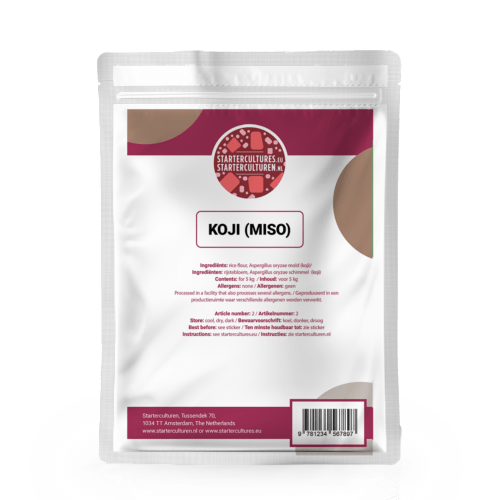Koji for miso | for miso and shoyu
This koji comes directly from Japan from the famous koji maker Hishiroku. It is best suited to make miso, but can also be widely used for shoyu, beans and other koji experiments. New: available for 5 or 200 kg of beans/grains.
Product Description
About koji
Koji is the fungus that can do anything: miso, soy sauce, shoyu, shio koji, amazake, black bean sauce, sake, doungjun, they all owe their taste to the fungus Aspergillus oryzae. This all-rounder can also be used, for example, to perform cool experiments with fermenting meat or even dairy.
This koji for miso type
This koji comes directly from Japan. It has moderate to strong α-amylase, protease. and glutaminase. This aspergillus easily produces koji which has less tightness, and a mild color. It is best suited to make miso, but can also be widely used for shoyu, beans and other koji experiments.
Content
- Ingredients: rice flour *, Aspergillus oryzae mold (koji)
- Available in two sizes: 15 gr. for 5 kg or 40 gr. for 200 kg of rice/barley/grain/soybeans
- Storage instructions: shelf life of the spores is at least 6 months in the refrigerator, more than one year in the freezer.
- Origin: Japan
- Soy-free
(*) The small standard packages contain pure spores mixed with rice flour. The spores are so light that they’re very difficult to dose accurately in small amounts of rice. The quantity is small, they tend to stick to the bag, and the slightest breeze can send them flying across your kitchen.
The bulk-use bags contain pure spores only — they are not mixed with rice flour, so the spore concentration is much higher. With just 40 grams, you can make, for example, 200 kg of product or 360 liters of shoyu, depending on the type of koji.
How to make koji-kin
Ingredients
- 300 g white rice, preferably not pre-cooked
- ca 1 g (about ½ tsp) koji-kin starter culture (check your packaging, different types of koji have different strengths)
Preparation
- Rinse the rice until the rinse water remains clear. Let it drain for 15 minutes.
- Steam the rice for about 45 minutes. That works better than cooking it. Cooked rice quickly becomes wet and mushy when moldy, which prevents the fungus from doing its job properly. The rice should look glassy and feel soft and a little rubbery when you bite it.
- Let cool to room temperature.
- Mix the koji kin with the rice and let it ferment for 48 hours in a warm humid place 25 to 35 ˚C. Check regularly. Make sure to avoid condensation dripping onto the rice.
- During this period, mix a few times with a clean fork. The fungus needs oxigen.
- The rice will be completely covered in a white mold after fermentation. Though keep in mind that different koji variants have different colors.
- Stop as soon as you start to see green or yellow dots. These means the fungus changes into the spore-forming phase. Use your nose (flowery, sweet) and tap the fermentation vessel to see if no (or few) spores have been formed when in doubt.
Online Miso making course
In 25+ bite-sized English spoken video lessons you will learn all about making Miso, without the need for special tools, in this online course by the founder of startercultures.eu. You will learn to make traditional, or ANY kind of Miso, save money, by never having to buy Miso again, and incite your culinary creativity!
Read More >
36 reviews for Koji for miso | for miso and shoyu
| 5 star | 86% | |
| 4 star | 13% | |
| 3 star | 0% | |
| 2 star | 0% | |
| 1 star | 0% |
This koji comes directly from Japan from the famous koji maker Hishiroku. It is best suited to make miso, but can also be widely used for shoyu, beans and other koji experiments. New: available for 5 or 200 kg of beans/grains.










Worked like a treat, was shipped quickly.
Ik heb de producten nog maar nauwelijks uitgeprobeerd. Ik vermoed dat het topkwaliteit is.
can now finally implement my miso ideas
Prima spul! Hele mooie Koji en Miso gemaakt
Nog niet gebruikt? Ik heb de producten nog niet gebruikt dus ik weet het nog niet,